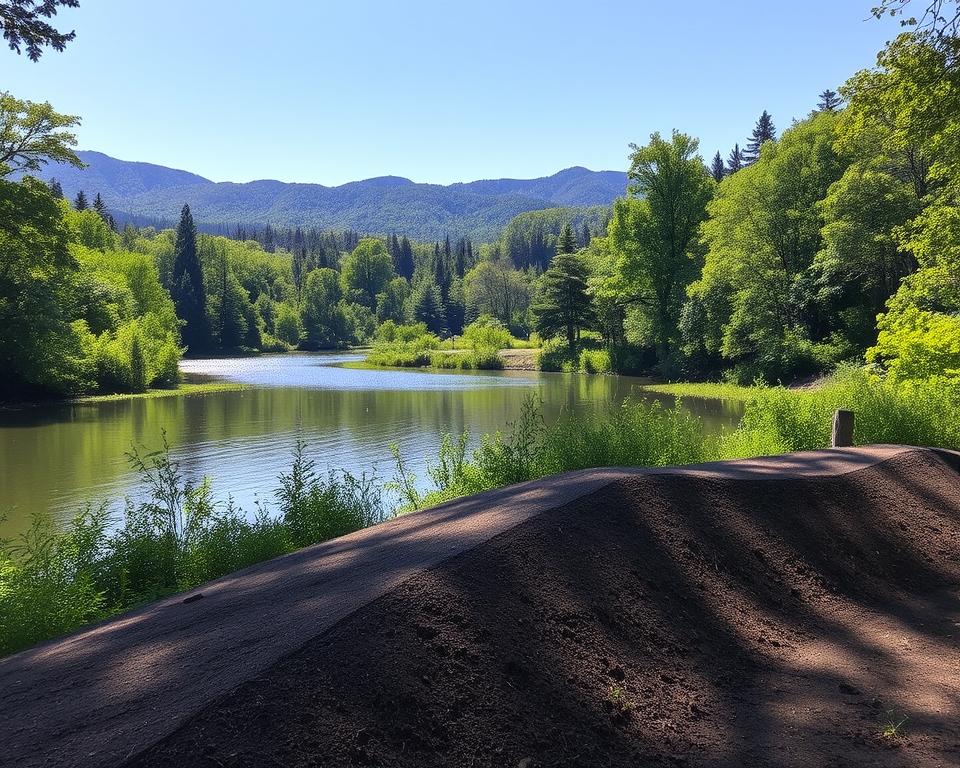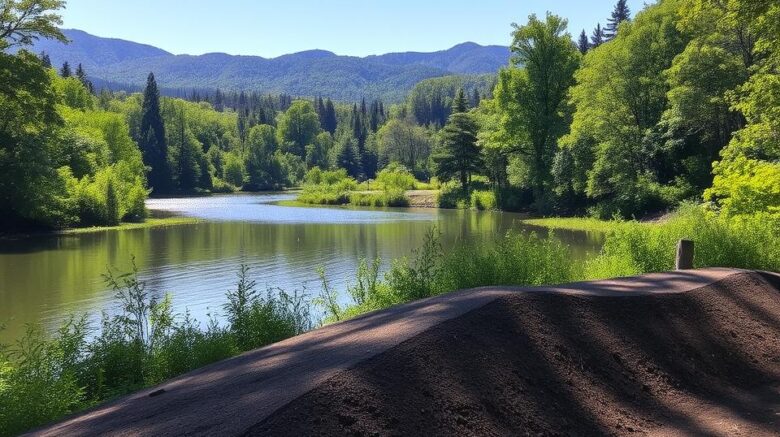Land Clearing Surrounding Water Sources: Best Techniques
Did you ever realize that nearly seventy percent of the planet’s fresh water supplies are threatened by agricultural drainage and Land Clearing? This alarming fact underscores the urgent necessity for responsible land management, essential during water source Land Clearing. Maintaining ecological accountability is vital for upholding ecological balance and preserving water quality and animal habitats. With increasing resource demands from communities, adopting sustainable land management practices is crucial. This approach promotes project success while mitigating soil erosion and minimizing pollution threats in aquatic ecosystems – land clearing services.
Critical Summaries
- Sustainable land management is crucial for preserving water quality.
- Adopting optimal practices reduces soil erosion and habitat loss.
- Awareness of environmental impacts is critical for responsible Land Clearing.
- Proper planning enhances project success while safeguarding ecosystems.
- Applying effective techniques encourages biodiversity in aquatic landscapes.
Comprehending Sustainable Land Clearing’s Importance
Land Clearing involves more than just uprooting vegetation. It has environmental consequences of Land Clearing that can harm areas around it, mainly near water. Standard techniques frequently result in soil erosion, ecological disturbance, and water pollution. It’s vital to grasp these effects to adopt better land management.
Environmental Consequences of Typical Land Clearing
Standard Land Clearing methods can cause many environmental issues. Soil erosion happens when vegetation is lost, degrading soil and causing sediment runoff into water. These sediments pollute water, affecting aquatic ecosystems. This process puts local wildlife at risk and disturbs ecosystem balance.
Sustainable Land Management Options
Adopting sustainable land management practices offers a solution to traditional clearing’s problems. Targeted clearing of select plants sustains ecosystem stability. Employing erosion control strategies—such as cover cropping—stabilizes soils and safeguards water purity. Prioritizing native vegetation supports wildlife and improves ecological health.
Top Best Practices for Land Clearing
Successful clearing projects hinge on a solid understanding of ecological factors. It’s vital to assess environmental goals to ensure clearing efforts are effective and sustainable. By setting clear objectives, landowners can make decisions that balance environmental preservation with development needs.

Assessing Your Environmental Goals
Before a clearing project, one must appraise environmental goals. This process includes analyzing the ecosystem and potential clearing effects on wildlife, soil, and water. Identifying personal objectives helps develop strategies that protect local habitats and watersheds.
Selecting the Optimal Time for Clearing
The scheduling of clearing activities influences success greatly. Winter and early spring are ideal, as the ground is frozen, reducing soil disturbance and erosion risks. Knowing when to avoid clearing can lead to healthier landscapes and lower environmental impact.
Understanding Local Clearing Regulations
Following local Land Clearing regulations is necessary for successful projects. Familiarity with permits sidesteps legal issues and fines. Reviewing local laws, especially near protected zones, prevents environmental mishaps due to unauthorized clearing.
Land Clearing Around Water Sources: Top Methods
Clearing strategies around aquatic sources emphasize safeguarding sensitive zones and preserving ecological equilibrium. A thorough approach involves identifying regions that require special care and implementing appropriate erosion control methods. These steps are critical for preserving biodiversity and maintaining water quality.
Identifying Sensitive Areas that Need Protection
Before clearing begins, identifying sensitive areas, such as wetlands and riparian buffers, is vital. These ecological hotspots filter pollutants and offer habitats for diverse species. By properly identifying these areas, land managers can devise strategies for protecting sensitive areas during and after the clearing process.
Applying Erosion Control Techniques
Once sensitive areas have been identified, effective erosion control methods must be employed to minimize sediment runoff into adjacent water bodies. Using silt barriers, buffer strips, and cover crops greatly aids in water quality protection. Emphasizing sustainable Land Clearing practices in combination with these erosion control measures fosters a healthier ecosystem around water resources. This ultimately benefits both the environment and local communities.
Mechanical Versus Manual Clearing Techniques
Choosing between mechanical and manual Land Clearing methods is critical. Each has its own set of advantages and disadvantages, affecting the environment and the clearing process’s efficiency. Recognizing these variations enables informed decision-making aligned with management aims.
Advantages and Disadvantages of Mechanical Clearing
Mechanical clearing uses heavy equipment for rapid removal of vegetation and debris. It speeds project timelines and reduces manual labor requirements. Nevertheless, machinery can disrupt soils, compact earth, and negatively impact ecosystems.
- Benefits: Efficiency in clearing large areas.
- Reduced labor costs.
- Suitability for challenging terrains.
- Drawbacks: Increased environmental impact.
- Risk of soil erosion.
- Threat of habitat loss.
Benefits of Manual and Selective Clearing
Manual and selective Land Clearing methods focus on ecological sustainability. Applying specialized labor limits soil disturbance and conserves plants. This method is ideal when maintaining biodiversity and ecological health are key.
- Advantages: Conservation of indigenous plants.
- Minimized soil disruption and erosion.
- Strengthened habitat protection for fauna.
Wetland Clearing Techniques
Wetland ecosystems are remarkable environments that play a vital role in maintaining ecological balance. They filter water, control flooding, and provide essential habitats for diverse flora and fauna. Grasping wetland ecology is critical for responsible clearing. The objective is to lessen disruptions and maintain these aquatic habitats.
Comprehending Wetland Ecosystems
Wetland ecosystems are characterized by their unique hydrology, soil types, and vegetation. They are transitional areas between land and water, hosting diverse fauna. They regulate water quality via natural filtration processes that extract contaminants. Maintaining wetland health fosters biodiversity and ecological durability.
Methods for Eco-friendly Wetland Clearing
Thoughtful planning and execution are required for responsible wetland clearing. Eco-conscious strategies lessen clearing’s ecological damage. Widely employed strategies include:
- Staged Clearing: Conduct clearing in phases to minimize ecological disruption, allowing time for wildlife to adapt.
- Targeted Clearing: Remove only specific vegetation types, preserving critical species for habitat stability.
- Regrowth Practices: Introduce practices that encourage natural vegetation regrowth after clearing, maintaining ecosystem functions.
- Establishing Buffer Areas: Establish buffer areas around sensitive wetland sections to protect aquatic habitats from disturbances.
Adopting these techniques ensures that responsible wetland clearing supports the ecological functions wetlands provide while reducing the risk of habitat destruction.
Protecting Riparian Reserves During Land Clearing
Riparian reserves are crucial for healthy water ecosystems. Positioned beside rivers and streams, these zones function as protective buffers. They safeguard water quality and enhance biodiversity. Implementing best practices prevents soil erosion, secures wildlife habitats, and sustains river ecology.
Role of Riparian Buffers in Aquatic Ecosystems
Riparian buffers are key to supporting aquatic ecosystems. They remove contaminants, reinforce banks, and host diverse species. They serve as barriers that lessen human impact on aquatic systems. By maintaining riparian reserves, water quality improves, and fish and other aquatic life thrive, making ecosystems more resilient.
Best Practices for Maintaining Riparian Zones
Effective riparian reserve maintenance involves these best practices:
- Avoid construction within buffer strips to minimize disturbance.
- Use native vegetation to stabilize banks and prevent erosion.
- Establish a diverse plant community to enhance habitat complexity and support wildlife.
- Manage invasive species to protect native plants and maintain ecosystem stability.
- Regularly assess soil health and water quality to guide management efforts.
Significance of Aquatic Land Clearing Strategies
Aquatic land clearing strategies are vital for ecological balance and healthy water systems. Managing water quality effectively during clearing minimizes pollution risks and supports sustainability. These strategies prevent sediment runoff and improve aquatic ecosystem health.
Assessing Water Quality and Sediment Management
Effective water quality management starts with assessing local water bodies. Clearing adjacent to water systems must avoid sediment deposits that damage water quality and aquatic organisms. Strategies include:
- Establishing buffer zones to filter pollutants
- Using sediment traps and barriers to minimize runoff
- Selecting clearing times to coincide with low water levels
Such measures preserve water quality and uphold ecosystem integrity. Retained vegetation helps control sediments and cycle nutrients, resulting in healthier water systems.
Aquatic Biodiversity Protection
Maintaining biodiversity in aquatic landscapes is key for resilient ecosystems. Aquatic land clearing should preserve native species, which are vital for these habitats. Steps to boost biodiversity include:
- Conserving critical habitats during clearing processes
- Implementing phased clearing to allow wildlife adaptation
- Restoring natural vegetation post-clearing to enhance habitat
By adopting these measures, land managers can foster biodiversity in aquatic landscapes. This leads to more robust and adaptable ecosystems. These efforts safeguard water health and endorse sustainable land-use methods.
Considerations for Stream Bank Clearing
Stream bank clearing presents specific challenges that demand ecological and regulatory consideration. It’s essential to ensure the process respects riverbank considerations to preserve water sources’ ecological balance. Erosion, habitat loss, and water quality degradation necessitate strategic mitigation during clearing.
Challenges Faced During Stream Bank Clearing
Stream bank clearing involves various challenges. Erosion poses significant risks, leading to soil depletion and declining water quality. Habitat disruption impacts local wildlife, which depend on riparian zones. Lacking vegetation, stormwater flow intensifies, causing sediment buildup in streams. Such problems underscore the importance of managing stream banks effectively.
Erosion Mitigation and Flora Support
Addressing erosion is critical during stream bank clearing. Using indigenous vegetation fortifies banks. Root systems reduce erosion, promoting a sustainable habitat for local plants and wildlife. Periodic reviews in clearing guarantee efficacy and preserve riverbank ecology. Lush vegetation advances management objectives and sustains ecosystem health.
Conclusion
Implementing the best practices for Land Clearing around water sources is essential for maintaining ecosystem health. Stakeholders should emphasize sustainable land management. This method accomplishes objectives and defends natural resources. Careful planning and execution ensure Land Clearing operations safeguard aquatic ecosystems and preserve biodiversity.
Locating sensitive zones and applying erosion controls are fundamental steps. Combining mechanical and manual methods supports landowners and contractors in responsible land management. Eco-friendly practices promote a balance between human activities and nature. This maintains vibrant, resilient water sources and adjoining landscapes.
Sustainable land management demands collective commitment. Every action during Land Clearing operations impacts watershed health. Integrating eco-responsible practices allows a future of harmonious agriculture and nature.
